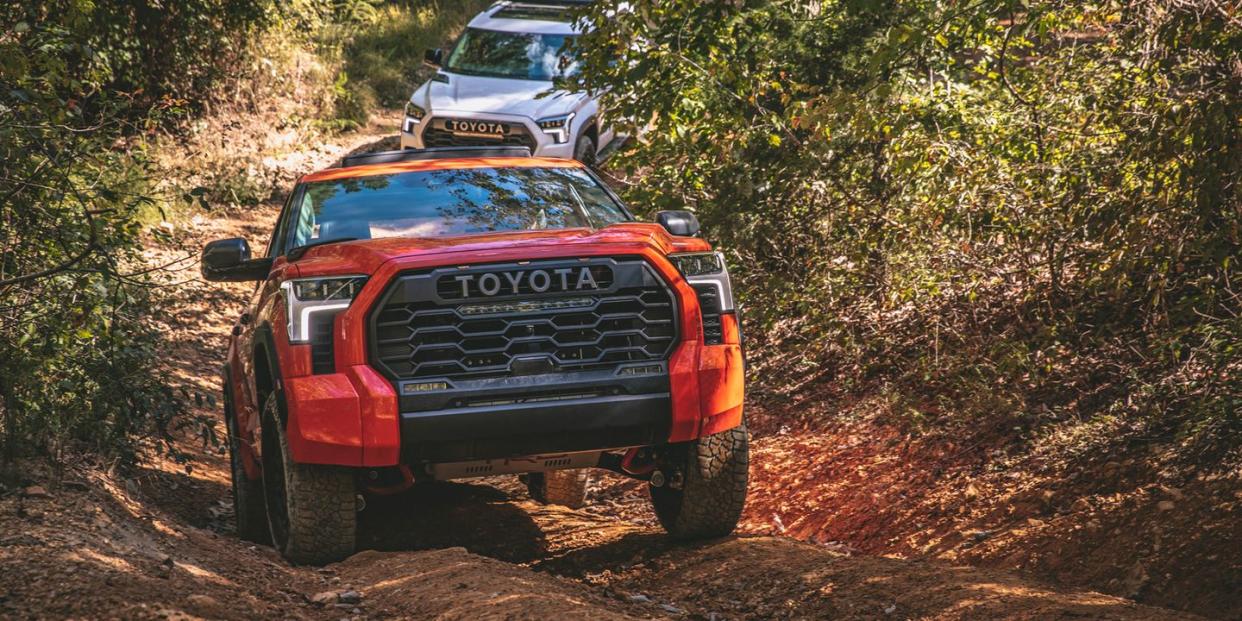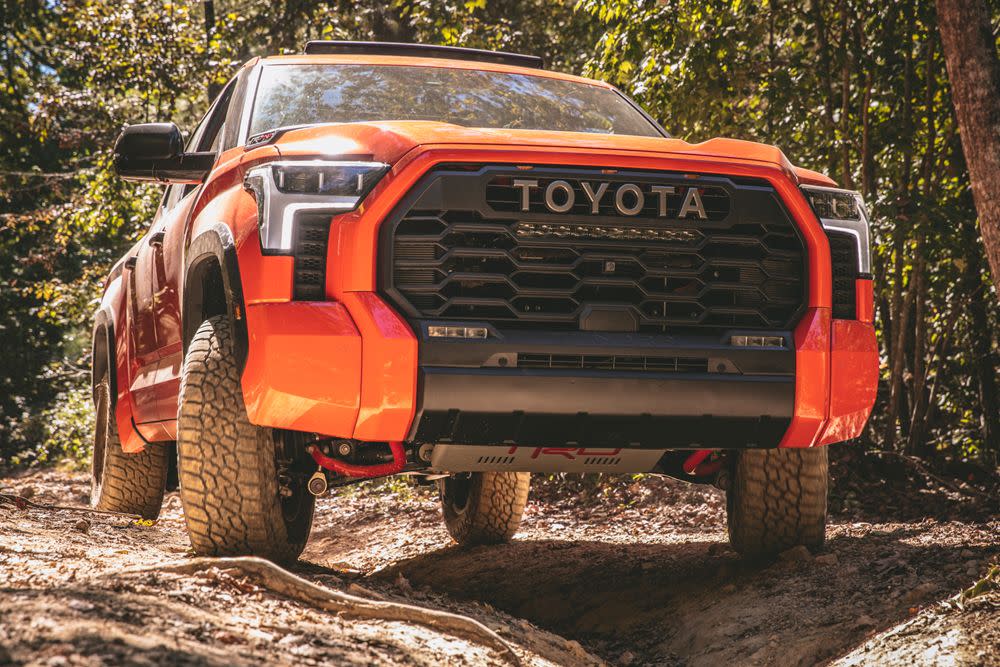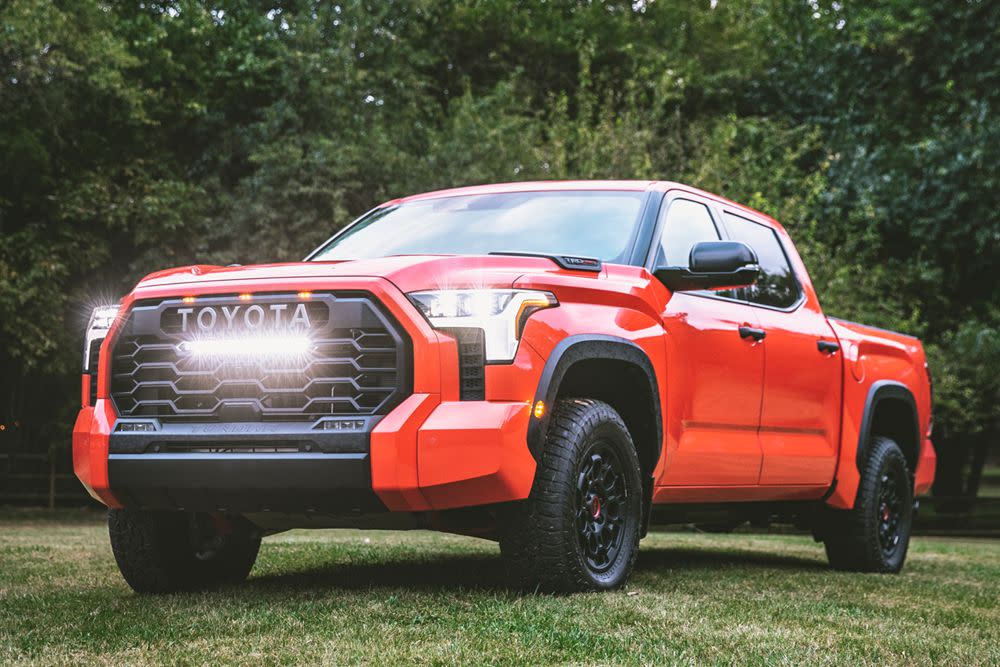Toyota's Tundra TRD Pro Brings the Noise When the Pavement Runs Out

In 2021, we saw the rollout of the latest third-generation Tundra. We drove it and loved it, but wanted to have a closer look at how it performed off-road. That’s why we flew down to Calhoun, Georgia, to give the pickup a proper workout on some more demanding trails. Its combination of mechanical ability and clever trail tech made for a comfortable and confidence-inspiring experience from behind the wheel.
Specs:
Base Price: $68,500
Engine: Twin-turbocharged 3.4-liter V6 (with mild hybrid)
Horsepower: 437 hp
Torque: 583 lb-ft
Transmission: 10-speed automatic
Drivetrain: Selectable 4-wheel dive
Fuel Efficiency: 22 mpg (combined)
Rad Features
Toyota’s latest Tundra TRD Pro is a spaceship compared to the basic manual-transmission Ford Bronco we drove earlier this year. Its 360-degree suite of cameras outside the vehicle allowed me to get a preview of what lay ahead from the comfort of the cabin. That’s not to mention other features like crawl control and Multi-Terrain Select.
Crawl control (essentially off-road cruise control) has advanced leaps and bounds since the systems in the early 2000s that drove in a much more binary on-off manner. Available on TRD Pro and TRD Off-Road packages, it works in tandem with the Electronic Stability Control (ESC) system to keep the vehicle moving without spinning the wheels. While crawl control is generally reserved for more technical obstacles, it worked a treat on some of the steeper and looser climbs where traction was limited. Even in the slowest setting (where momentum wasn’t helping me), it was able to mitigate wheel slip and tractor up some of the steepest climbs on the course—I’d estimate these at a speculative 30-percent grade.
Multi-Terrain Select (MTS) is much more active, tailoring the dynamics of the vehicle to the terrain that you’re rolling over. When active, it regulates wheelspin, brake pressure, and throttle response to optimize traction in specific conditions—with different modes for mud, sand, rock, and automatic. Sure, most of the course we were on could be tackled in 4-High, but it’s good to know that the Tundra can tackle more demanding terrain should it arise.
Mechanical Advantages

Critically, the new Tundra’s rear axle uses coil springs instead of leaf springs. While the latter has been the industry standard for decades, able to hold heavy loads, leaf springs tend to be rough as old bolts while driving off-road. Meanwhile, coil springs are much more compliant and can offer up more articulation—making them better for off-road applications.
While none of the maneuvers at the off-road park forced the Tundra into extreme amounts of articulation, its compliance really shined on bumpy terrain. We never got to tackle any of the more demanding features, but the suspension was surprisingly supple for a 6,015-pound truck. Coming from my extensive experience of testing leaf-sprung vehicles off-road, the Tundra’s suspension feels comparatively tuned for more high-speed work, but still tackles slow and steady four-wheeling just fine.
With the majority of modern pickup trucks prioritizing cabin space and on-road comfort, it’s become increasingly challenging to prioritize off-road capability. Just look at the big T’s bespoke set of Falken Wildpeak all-terrain tires, which are designed and built specifically for the Tundra to mitigate road noise and maximize fuel efficiency. You’ll notice that you won’t see the same tread depth as a standard set of Wildpeaks that you’d find at your local tire depot.
I’m pleased to report that the standard rubber was more than adequate for the off-road course I tackled. Conditions were relatively dry, and I had plenty of traction without needing to air down the tires. Crawling up some of the steeper sections, I tried to go as slow as possible, forcing the truck to find traction on its own—momentum often allows you to cheat traction. Even without any of its advanced systems enabled, the Tundra could find grip and giddyup.
The Elephant(s) in the Room

The front grille on the latest crop of half-ton pickup trucks just seem to keep growing. And the Toyota Tundra is no exception. Ever since the Tundra’s debut, its big honking grille has been a popular talking point—both for its aesthetics and close proximity to the ground. Looks may be subjective, but I’m pleased to report that I never ran out of clearance under the front end. To offer some perspective, the Tundra TRD Pro presents an approach angle of 26.2-degrees, which is comparable to most half-ton pickups.
Enthusiasts also tend to bash the new Tundra for its lack of front recovery points. While part of me agrees this is a bit silly, Toyota knows that the majority of buyers won’t be tackling anything more difficult than the Starbucks drive-thru. That’s not to mention that there are bound to be aftermarket options out there. Toyota has already shown a preview of what these mods could look like with its “Desert Chase” concept.
The Verdict
Should you take the latest Tundra TRD Pro off-road? Absolutely. It’s one of the most capable half-ton pickup trucks that we’ve driven on dirt. It simply felt like it was in low-Earth orbit while tackling some of the more challenging obstacles at the off-road park.
While the Tundra was super capable in stock trim, light modifications—i.e. beefier tires, high-clearance bumpers, and a lift kit—will make it simply unstoppable off-road.
You Might Also Like
